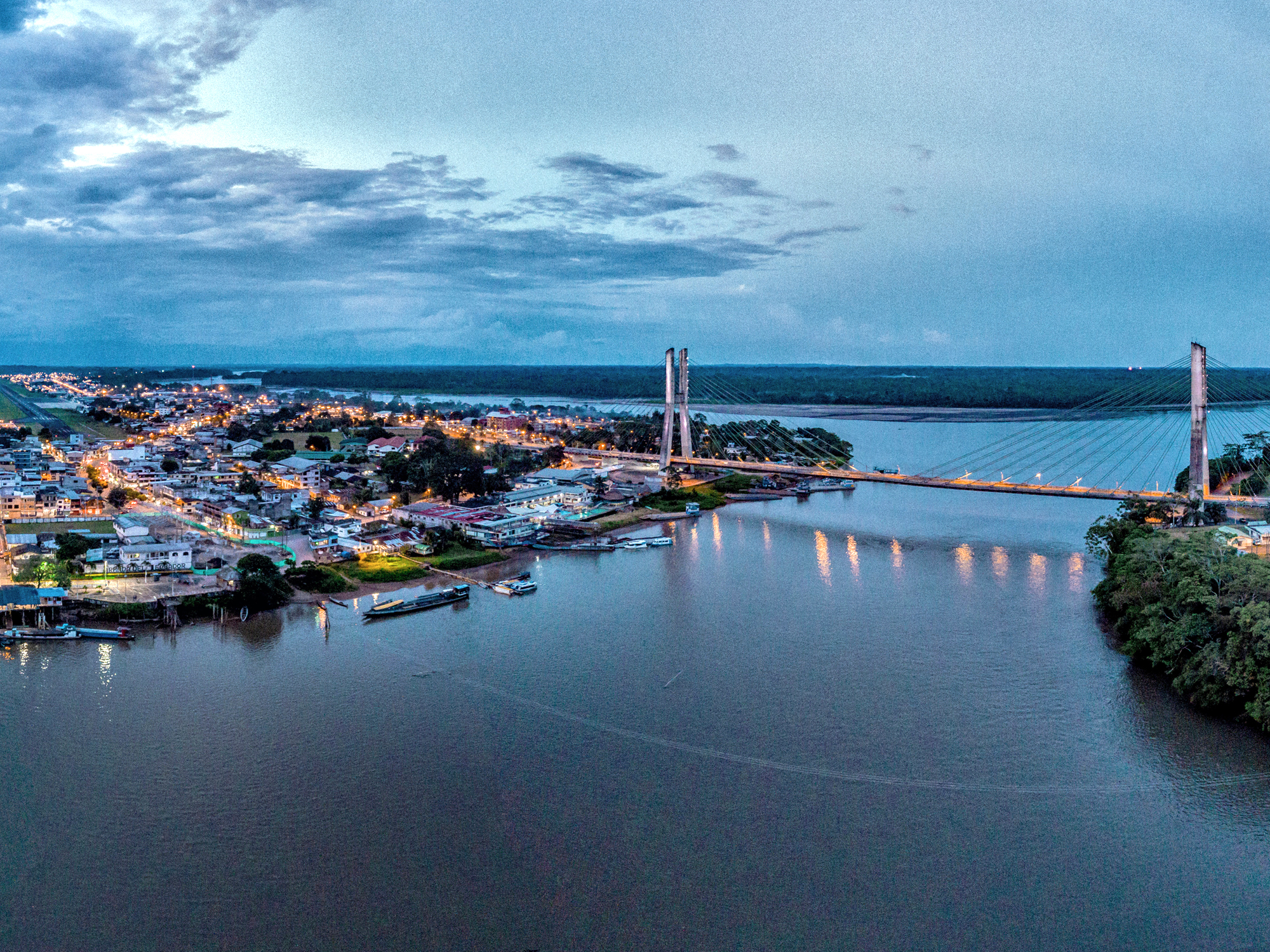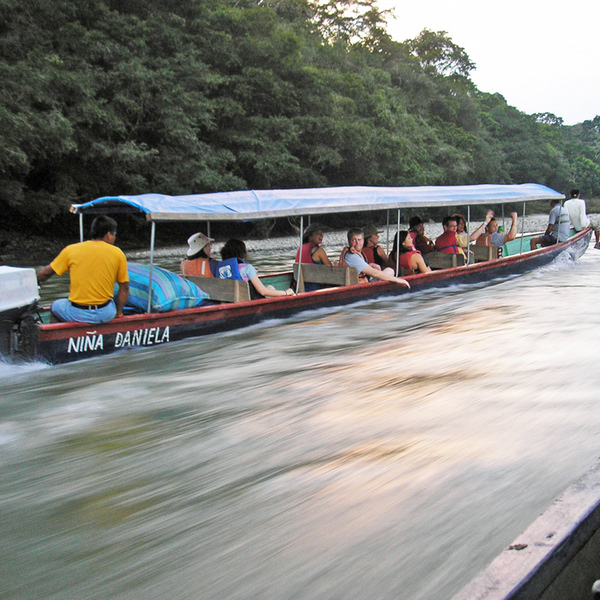Coca has got attitude!
You, my bus traveling buddies, are catching on to the lesser appreciated “El Oriente” (the eastern Amazon side of Ecuador). It is showing in the increasing number of bus tickets you’re asking us to reserve for you here on EcuadorBus to places like Coca. Even during COVID, lots more people than before were trending toward experiences in the jungle versus the mountains.
And I get why!
I recently revisited Coca, Ecuador to catch up on its progress of being the hip and cool corner of the Amazon rainforest, and most of the municipal infrastructure projects that previously had half the town torn up, are done and over. Sure, the city still cannot escape the jungle — the forest is constantly trying to swallow up houses and concrete cannot fight off the hot mildew that stains walls black. That goes with the territory. But fighting seems to be what the people of Coca do to make this town the place they want to thrive, and they’re doing a good job.
The town of Coca (formally named as Francisco de Orellana) is gradually getting the feel of becoming the Baños of the jungle (Baños, the independent traveler’s haven in the cloud forest of central Ecuador).
Getting to Coca by bus
Getting to Coca by bus is not complicated at all, which is good for
those concerned about the thought of going all the way from the heights
of the Andes to the Amazon rainforest in a relatively short distance.
You can book a bus seat in advance from Quito to Coca through our home page on this site, which is about an 8-hour trip for less than USD $20. It winds its way on good roads over the mountain pass, and down through the cloud forest around Baeza until it fades into the jungle highway going toward Coca.
Bear in mind, however, that in rainy seasons (April-May and October-November), that mudslides are a common nuisance and bring mud down over the road, delaying or blocking traffic until the tractors come and push it away.


There are also smaller shared cars and vans that run about $46 per person and that carry only small quantities of passengers, but they have regularly scheduled departures the same as buses, although their schedules are less reliable. Both buses and shared shuttles can be looked up on our home page.
Lastly, you can always arrange a private transfer, which is especially desirable to those leaving from or getting back to the airport and have more strict time requirements. You can order these private shuttles on our shuttles page.
Some history about Coca
Coca’s beginnings as a human settlement date from the pre-Inca ages. It was known for its cinnamon and small cash crop plantations.
The other resource was gold! Shiny treasures got the attention of hundreds of Spanish explorers that arrived with fleets of men to discover what this land had to offer.

In 1538, Gonzalo Diaz de Pineda was the first explorer that arrived in these lands (and rivers!) looking for the infamous city of El Dorado. A few years later, Francisco Pizarro, another Spanish conqueror arrived by following its main rivers, the Napo and Coca. These rivers eventually led him to discover the Amazon River, and that fluvial connection is still utilized by locals and foreigners to go even deeper into the jungle all the way to Peru.
Years later, with the boom of oil extraction, the city of Coca, Ecuador grew rapidly, attracting adventurous explorers in the quest for the “black gold” and all the business that surrounds this industry. It is a similar story with other small towns in the jungle of the Amazon region, like Lago Agrio (Nueva Loja) just two hours farther north.
Coca: a modern town in the Jungle
Long gone are those days where people were just arriving for the treasures hidden in this city, and indeed, the city has come a long way. There’s a new boardwalk along the river, several sporty bars, and restaurants. There’s also a multiplex cinema (I think the only town in Ecuador’s jungle to boast one) on top of a building that towers over the river Napo and gives you a commanding view of the rainforest stretching out to the horizon. Oh, and a new, very stylish archaeological museum.
I also don’t know of a city nearby where on many side streets outside the tourist groove you can still find several independent cultural exhibits and art galleries, but all without the town looking anything close to nouveau riche. It’s still got that brotherly vibe with other Oriente towns: scrappy, hustling, and hot.

But wait, the Coca bus station is still a ways from town…
I made the mistake of thinking Coca was a small enough town that I could just step off the bus and be a couple of blocks from the middle of town. So I just started meandering while I munched on some peanuts.
As I walked down the highway from the bus station to the town center, construction workers were tearing up block after block and re-plumbing the houses on top. These are sure signs of a frenzied boom of renewal that will propel the city into its next era as if they fear losing the chance if they don’t do it all right now.
After about 10 minutes, I felt something was wrong, and I was just stuck out in a macabre of sprawling overgrowth where dilapidation and reconstruction just kind of pile on top of each other. It turns out that the bus terminal is a loooong way away from the city center, second only to Quito’s bus terminals and their distance from downtown Quito. So, you can’t just casually walk from the bus to town. In fact, the police stopped me apparently because they don’t see travelers just walking the distance, and so they gave me a hard line of questioning as to why I was not hailing a taxi. I told the officer the truth, that I just didn’t know it was such a long way, and I did relent and flagged down a yellow. But in truth, I wanted to punch him in the nose for being an a**hole.
Where to stay...
Hotels here (and even hostels) are sadly three to four times more expensive than those found elsewhere in Ecuador. Some cheap options can be found near the bus terminal, but as I said earlier, the bus hub is a considerable walking distance from the city center where the port and other attractions are found. You can use a taxi to commute between the bus terminal area to the town center and just negotiate with the driver if you are planning several trips to the city while you explore the area.
Explore Coca by water and boats!

During high season, apart from more buses from Quito to Coca, most people use Coca as the departure point to one of the most popular activities, sailing on the Napo River, which eventually empties into the Amazon River. In fact, navigating the Napo is the only means of access to the area’s many lodges, which are the most commonly sought out (but expensive) accommodations because it is from these lodges that tours and packaged excursions commence into the surrounding rainforest and indigenous villages. From Coca, you can also embark on the journey to visit Yasuni, one of the largest reservoirs of fauna and flora on the planet, an ecological Shangri-la.
As most travelers coming to Coca are just using it as their point of disembarkation for the deep jungle upriver, a lot of fun activities are related to day-trips in shared boats. Some options may be visiting Isla de Monos (Island of Monkeys), a piece of land composed of sediment from the river. Another option is to visit community tourism projects like the Jumandy, an indigenous community that offers tours to experience a “limpia” (an ancestral ritual that aims to cleanse the body and spirit).
Get to Peru? The wet road to the border
As I was digging around for more information about what to do in town, some people told me that just over my shoulder there were boats loading passengers to go all the way to Peru! The border with Peru is around 18 hours away by boat, but going there is not as complicated as it sounds. Boats from Coca to Nuevo Rocafuerte run twice a week, and while they are not that comfortable cruise liners by any means, they mostly have padded seats and backrests and a canvas roof to block the sun. This service is popular among locals who want to go to the border to do business with Peruvians.
But past Nuevo Rocafuerte, there’s more!
Coca also connects to Iquitos, in Peru, the gem of the Peruvian Amazon. Many stories are told about this route of a life-changing journey, and I can recommend it to those who are willing to go deeper into the jungle for three days and explore exotic animals and impressive sunsets. This service departs only once a week, and departures are usually arranged ahead of time, so I’d recommend booking your trip here.
Once your trip is confirmed, make sure you get some pop-top canned food (tuna, beans, or soup) as the service does not include meals. While the boat strategically stops at some riverside communities, those are not good ideas for weaker stomachs because the means of cooking are often unsanitary. At night, the sailor tells you where to stay (usually cheap hostels to just spend the night).
Land journey: buses from Coca to nearby cities

Coca is not just about the river and long journeys on water. For bus travelers, a good side attraction is to take a short day trip from Coca to Limoncocha, where they have a more rustic home-grown cultural and artifact museum that feels more authentic than city museums. Along the way, you’ll go through Shushufindi, the heart of Ecuador´s oil fields, and witness the extent to which the government is investing in pulling crude from the ground.
There are various routes to and from Coca to meet the demands of different itineraries. While I came into Coca from the north through Lago Agrio and Sachas, another route that cuts more directly through the jungle is through Loreto. If you’re coming from the South, like Guayaquil or Cuenca, you probably want the buses that cut over through Baños to Puyo, and then Puyo to Coca (through Loreto).

Kali Kucera is President of AndesTransit and also known as "the bus guy" for his adventures across South America by bus. He is the co-author of "South America Borders" and "365 Days of South American Festivals." available through AndesTransit Freebies Portal.



